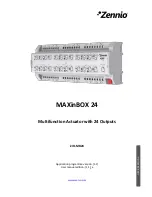
- 14 -
System Troubleshooting
Regulator Troubleshooting
The majority of charging difficulties can be attributed to damage, corrosion or wear at wiring, fusing or wiring connec-
tions. Before attempting to troubleshoot alternator or regulator issues, be sure to address the following:
Remove and clean all charging system electrical
1.
connections (positive and negative). Check the volt-
age regulator’s harness for continuity. Wires and
terminals can and will become corroded, and need to
be cleaned or replaced. Ensure that the regulator’s
ground wires are provided with a clean connection to
system ground.
Inspect and replace 10A ATC type fuse in the regula-
2.
tor wiring harness if fuse appears to be damaged or
corroded. Ensure that the fuse holder is also free of
corrosion.
Charge all batteries to their proper fully charged state,
3.
and determine if they are serviceable. If your batteries
are flooded-type, use your hydrometer to determine
their condition.
Check and tighten alternator belt. If the belt show signs of wear or damage, replace it. Always replace existing belts
4.
with the finest quality replacements available.
If batteries and wiring are in suitable condition, use the tests on the following page to determine if charging problems are
a result of a faulty alternator or regulator. These tests provide an opportunity to isolate the alternator, regulator and wir-
ing harness in order to determine the problem source. In order to perform these tests, you will need an independent DC
meter (preferably a digital type). In an emergency, a 12V light bulb or test light can be used to help determine if power or
working grounds exist. An amp meter and a battery hydrometer with a thermometer are also helpful diagnostic tools.
Voltage Regulator Testing
Set your voltmeter to 12VDC and connect the negative lead to the BLACK ground wire at the regulator as shown at in the
diagram at right.
With the ignition turned OFF, check voltage on the RED (power), BLUE (field) and BROWN (ignition) wires in the regulator
plug.
Voltages should be as follow:
RED wire equal to battery voltage
•
BLUE wire zero volts
•
BROWN wire zero volts
•
With the ignition in the ON position (engine not running), check voltage on the RED (power), BLUE (field) and BROWN
(ignition) wires in the regulator plug:
RED wire equal to battery voltage
•
BLUE wire between 4V and 11V
•
BROWN wire equal to battery voltage
•
PLEASE NOTE: In systems where the ignition (BROWN) wire is supplied power via an oil pressure switch, jump directly
from test #1 to test #3.
With the ignition in the ON position (with engine running at 1,400 rpm fast idle), check voltage on the RED (power), BLUE
(field) and BROWN (ignition) wires in the regulator plug. Voltages should be as follow:
RED wire equal to battery voltage
•
BLUE wire between 4V and 11V
•
BROWN wire equal to battery voltage
•


































